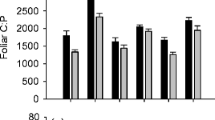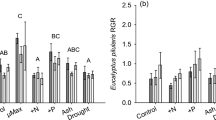Summary
Changes in soil and plant nutrient conditions were evaluated following various burn and clip treatments in a longleaf pine-wiregrass savanna in Bladen Co., N.C., USA. Ground fires were found to add substantial quantities of N, P, K, Ca, and Mg to the soil, though not necessarily in forms immediately available to plants. Less than 1% of the total nitrogen in the charred residue (ash) is present as nitrate or ammonium. Considerable quantities of all nutrients examined were lost to the atmosphere during burning. Green leaf tissue in recently burned areas was consistently higher in N, P, K, Ca, and Mg compared to unburned areas. Howerver, when compared to similar tissues from clipped plots, burned area tissues were significantly higher in N, Ca, and Mg only. Data presented here suggest that tissue age significantly affects nutrient content and must be considered in any analysis of tissue nutrient content following burning. Within 4–6 months following fire, burned-area tissue nutrient content decreases to concentrations found in the unburned area. Burning resulted in initial enrichment of available soil nutrients including PO4, K+, Ca++, and Mg++, however, NO3 -, and NH4 + concentrations in burned soil were not significantly different from unbruned soil. Soil and plant nutrient changes in an area burned two years in succession indicate that repeated burning may diminish nutrient availability. Plant response to various nutrient enrichment treatments of the soil indicated that nitrogen is limiting growth in both burned and unburned soils and that burning may alter some factors other than nutrients which may retard plant growth in unburned areas.
Similar content being viewed by others
References
Barnette, R.M., Hester, J.B.: Effect of burning upon the accumulation of organic matter in forest soil. Soil Sci. 29, 281–284 (1930)
Barr, A.J., Goodnight, J.H., Sall, J.P., Helwig, J.T.: A users guide to SAS 76, 329 pp. Raleigh, N.C.: SAS Inst. 1976
Bartholomew, B.: Bare zone between California shrub and grassland communities: The role of animals. Science 170, 1210–1212 (1970)
Bremner, J.M.: Total nitrogen, pp. 1149–1178. In: Methods of soil analysis (C.A. Black, ed.), no. 9, Vol. 2. Madison, Wisc.: Amer. Soc. Agron. Monogr. 1965
Buol, S.W.: Soils of the Southern States and Puerto Rico. Southern Cooperative Series Bulletin No. 174, 105 pp. (1973)
Burns, P.Y.: Effects of fire on forest soils in the pine barren region of New Jersey. Yale Univ. School of Forestry Bull. 57, 50 pp. (1952)
Christensen, N.L.: Fire in Southern Forest Ecosystems. In: USDA Forest Service, Symposium: Fire by prescription, Atlanta, Ga. (in press, 1977)
Christensen, N.L., Muller, C.H.: Effect of fire on factors controlling plant growth in Adenostoma chaparral. Ecol. Monogr. 45, 29–55 (1975a)
Christensen, N.L., Muller, C.H.: Relative importance of factors controlling germination and seedling survival in Adenostoma chaparral. Amer. Midl. Natur. 93, 71–78 (1975b)
Crooke, W.M., Simpson, W.E.: Determination of ammonium in Kjeldahl digests of crops by automated procedure. Sci. Food Agr. 22, 9–10 (1971)
DeBell, N.V., Ralston, C.W.: Relaease of nitrogen by burning light forest fuels. Soil Sci. Amer. Proc. 34, 648–653 (1970)
Dickman, S.R., Bray, R.H.: Colorimetric determination of phosphate. Ind. Eng. Chem. Anal. Ed. 12, 665–668 (1940)
Garren, K.H.: Effects of fire on vegetation of the southeastern United States. Bot. Rev. 9, 617–654 (1943)
Greene, S.W.: Effects of annual grass fires on organic matter and other constituents in virgin longleaf pine soils. J. Agric. Res. 50, 809–822 (1935)
Hardy, A.V.: Climate of North Carolina. U.S. Dept. Commerce Pub., Climatography of the United States no. 60-31, 21 pp. (1970)
Harper, R.M.: The relation of climax vegetation to islands and peninsulas. Bull Torrey Bot. Club 38, 515–525 (1911)
Henrikson, A., selmer-Olson: Automatic methods for determining nitrate and nitrite in water and soil extracts. Analyst 95, 514–518 (1970)
Heyward, F., Barnette, R.M.: Effect of frequent fires on chemical composition of forest soil in the longleaf pine region. Fla. Agr. Exp. Sta. Bull. 265 (1934)
Jorgensen, B.R., Wells, C.G.: Apparent nitrogen fixation in soils influenced by prescribed burning. Soil Sci. Soc. Amer. Proc. 35, 806–810 (1971)
Komarek, E.V.: Effects of fire on temperate forests and related ecosystems: Southeastern United States, pp. 251–278. In: Fire and ecosystems (T.T. Kozlowski, ed.), 542 pp. New York: Academic Press 1974
Komarek, E.V., Komarek, B.B., Carlysle, T.C.: The ecology of smoke particulates and charcoal residues from forest and grassland fires: A preliminary atlas. Tall Timbers Research Station, Misc. Pub. no. 3, 75 pp. (1973)
Lee, W.D.: The soils of North Carolina. North Carolina Agric. Exp. Sta. Tech. Bull. no. 115, 187 pp. (1955)
Lemon, P.C.: Successional responses of herbs in the longleaf-slash pine forest after fire. Ecol. 30, 135–145 (1949)
Lemon, P.C.: Effects of fire on herbs of the southeastern United States and central Africa. Proc. Tall Timbers Fire Ecol. Conf. no. 6, pp. 112–127 (1967)
Lewis, W.N., Jr.: Effects of fire on nutrient movement in a Sout Carolina pine forest. Ecol. 55, 1120–1127 (1974)
Machlis, L., Torrey, J.G.: Plants in action, 282 pp. San Francisco: Freeman 1956
Metz, L.J., Lotti, T., Klawitter, R.A.: Some effects of prescribed burning on coastal plain forest soil. USDA Forest Service Paper SE-113, 10 pp. (1961)
Mendoza, A., Montes, R.A., Medina, E.: Balance nutricional y production de material organica en las savanas de Trachypogon de Calabazo, Venezuela. Tropical Ecology (in press)
Muller, C.H., Hanawalt, R.B., McPherson, J.K.: Allelopathic control of herb growth in the fire cycle of the California chaparral. Bull. Torrey Bot. Club. 95, 225–231 (1968)
Mutch, R.W.: Wildland fires and ecosystem—a hypothesis. Ecol. 51, 1046–1051 (1970)
Nelson, W.L., Mehlich, A., Winters, E.: The development, evaluation, and use of soil tests for phosphorus availability. Agron. 4, 153–188 (1953)
Odum, E.P., Pomeroy, S.E., Dickinson III, J.C., Hutcheson, K.: The effects of late winter burn on the composition, productivity, and diversity of a 4-year old fallow field in Georgia. Proc. Tall Timbers Fire Ecol. Conf. no. 13, pp. 399–420 (1973)
Parrott, R.T.: A study of wiregrass (Aristida stricta) with particular reference to fire. Unpublished M.S. thesis, Duke University, Durham NC., 137 pp. (1967)
Ralston, C.W., Hatchell, G.E.: Effects of prescribed burning on physiological properties of soil, pp. 68–83. In: Prescribed Burning Symposium Proc., USDA Forest Service, Asheville, NC., 160 pp. (1971)
Roberts, P.R., Oosting, H.J.: Responses of venus fly trap (Dionaea muscipula) to factors involved in its endemism. Ecol. Mongr. 28, 193–218 (1956)
Steward, K.K., Ornes, W.H.: The autecology of Sawgrass in the Florida Everglades. Ecol. 56, 162–171 (1975)
Vlamis, J., Gowan, K.D.: Availability of nitrogen, phosphorus and sulfur after brush burning. J. Range Manage. 17, 73–74 (1957)
Volg, R.J.: Fire in the southeastern grasslands. Proc. Tall Timbers Fire Ecol. Conf., no. 13, pp. 175–198 (1973)
Wahlenberg, W.G.: Longleaf pine: its use, ecology, regeneration, protection, growth and management. Chas. Lathrop Pack For. Found. and USDA Forest Service, Washington, D.C., 429 pp. (1946)
Wells, B.W.: Ecological problems of the southeastern United States coastal plain. Bot. Rev. 8, 533–561 (1942)
Wells, B.W., Shunk, I.M.: The vegetation and habitat factors of the coarser sands of the North Carolina coastal plain. Ecol. Monogr. 1, 465–520 (1931)
Wells, C.G.: Effects of prescribed burning on soil chemical properties and nutrient availability, pp. 86–99. In: Prescribed Burning Symp. Proc. USDA Forest Service, Asheville, N.C., 160 pp. (1971)
Author information
Authors and Affiliations
Rights and permissions
About this article
Cite this article
Christensen, N.L. Fire and soil-plant nutrient relations in a pine-wiregrass savanna on the coastal plain of North Carolina. Oecologia 31, 27–44 (1977). https://doi.org/10.1007/BF00348706
Received:
Issue Date:
DOI: https://doi.org/10.1007/BF00348706




